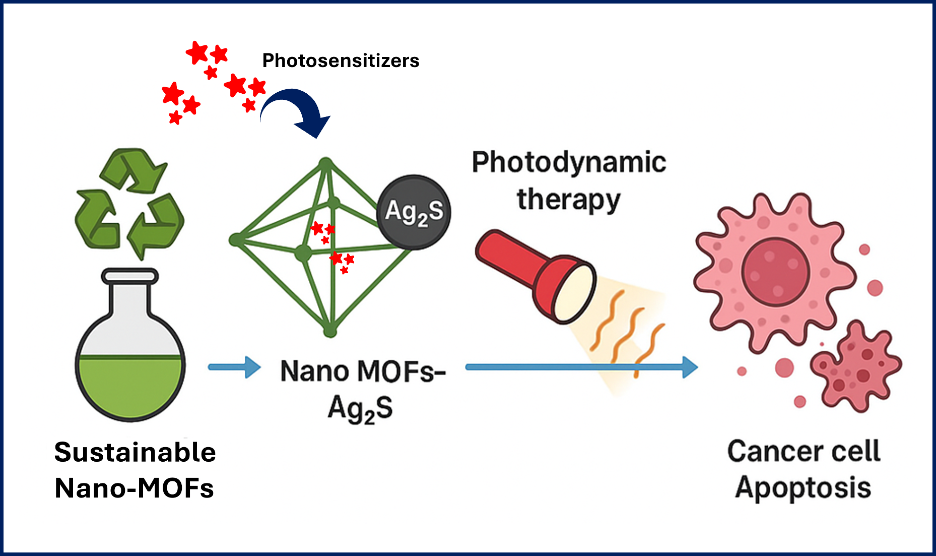Developing Next-Generation Nanoscale Metal–Organic Frameworks
Cancer remains one of the most pressing global health challenges. While chemotherapy has long been a mainstay treatment, its non-specific action often damages healthy tissues, causes severe side effects, and contributes to drug resistance over time. As a result, researchers are increasingly turning toward innovative alternatives such as photodynamic therapy (PDT). PDT utilizes special light-sensitive molecules, known as photosensitizers (PSs), which generate toxic reactive oxygen species (ROS) upon exposure to light and destroy cancer cells with greater precision. Despite its promise, PDT faces significant limitations. Tumors often have low oxygen levels (hypoxia), making ROS production less effective. At the same time, cancer cells contain high concentrations of glutathione (GSH), a natural antioxidant that neutralizes ROS and helps tumors survive. These biological challenges reduce the therapeutic impact of PDT.
Our work aims to overcome these barriers by developing next-generation nanoscale metal–organic frameworks (nanoMOFs) as sustainable photosensitizers and drug delivery platforms. MOFs are crystalline, porous materials formed by metal ions linked with organic ligands. At the nanoscale, they provide a highly tunable platform for loading drugs or PSs while enabling efficient ROS generation. Importantly, we focus on redox-active metals, which not only support PDT but also actively deplete intracellular GSH via redox cycling, weakening cancer cells' antioxidant defenses and enhancing treatment efficacy. Additionally, nanoMOFs offer an excellent platform for combination therapies. They can carry chemotherapeutic drugs alongside photosensitizers, making photo–chemo combination therapy possible within a single system. Their porous structure allows for high loading of drugs or PSs, and their surfaces can be functionalized with targeting ligands, ensuring that treatments act primarily on cancer cells while sparing healthy tissue. Hybrid composites with quantum dots, magnetic nanoparticles, or biopolymers further enhance imaging, targeting, and therapeutic performance.
A major focus of our research is on sustainability. Currently, MOF synthesis methods are energy-intensive and not eco-friendly, often producing large, unstable particles with limited biomedical applications. We can synthesize smaller, more stable, and biocompatible nanoMOFs that are safer for patients and more scalable for real-world applications.
By combining cutting-edge nanotechnology, sustainable chemistry, and cancer biology, our approach seeks to redefine how light-based therapies are delivered. These smart, eco-friendly nanoMOFs are designed not only to overcome the long-standing limitations of PDT but also to serve as versatile platforms for drug delivery and combination treatments. In the long run, this synergistic strategy has the potential to provide cancer patients with therapies that are safer, more targeted, and significantly more effective than conventional options available today.

Author: Ankush D. Sontakke, PhD
NanoBio4Can MSCA Co-Fund Fellow
Koç University Translational Medicine Research Center (KUTTAM)